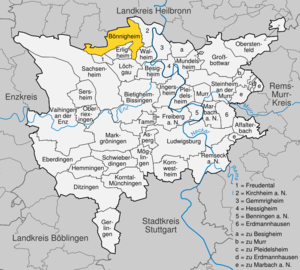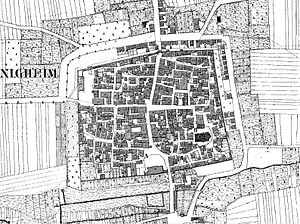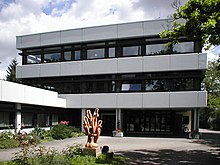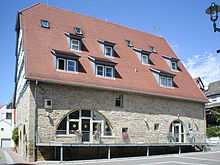Bönnigheim
| coat of arms | Germany map | |
|---|---|---|
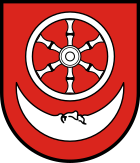
|
Coordinates: 49 ° 2 ' N , 9 ° 6' E |
|
| Basic data | ||
| State : | Baden-Württemberg | |
| Administrative region : | Stuttgart | |
| County : | Ludwigsburg | |
| Height : | 221 m above sea level NHN | |
| Area : | 20.14 km 2 | |
| Residents: | 8015 (December 31, 2018) | |
| Population density : | 398 inhabitants per km 2 | |
| Postal code : | 74357 | |
| Area code : | 07143 | |
| License plate : | LB, VAI | |
| Community key : | 08 1 18 010 | |
| LOCODE : | DE OGM | |
| City structure: | 3 sub-locations | |
City administration address : |
Kirchheimer Strasse 1 74357 Bönnigheim |
|
| Website : | ||
| Mayor : | Albrecht Dautel | |
| Location of the city of Bönnigheim in the Ludwigsburg district | ||
Bönnigheim is a town in the north of the Ludwigsburg district in Baden-Württemberg . It belongs to the Stuttgart region (until 1992 the Middle Neckar region ) and the European metropolitan region of Stuttgart .
geography
Geographical location
Bönnigheim is prior to the northeast edge of the Stromberg's in the subspace Zabergäu the neighboring nature, space Neckarbecken in a small valley of millstream . The Mühlbach flows into the neighboring municipality to the east of Kirchheim a. N. from the left into the Neckar .
The closest larger cities are Ludwigsburg about 16 km in the south and Heilbronn about 14 km in the northeast, each measured as the crow flies.
The majority of the community area is predominantly agricultural land. But there is also a significant proportion of settlement area. An extension of the marking area in the west extends to the first, fully wooded, heights of the Stromberg.
Community structure
The formerly independent municipalities Hofen and Hohenstein belong to Bönnigheim.
The city of Bönnigheim and the Burgermühle house as well as the abandoned village of Birlingen belonged to the city of Bönnigheim within the limits of December 31, 1971 .
The village of Hofen belonged to the former municipality of Hofen .
The village of Hohenstein belonged to the former community of Hohenstein .
Division of space

According to data from the State Statistical Office , as of 2014.
history
Development of the city
The first written mention of Bönnigheim can be found in the Lorsch Codex . In a document dated February 16, 793, the nun Hiltburg bequeathed the communities of Bönnigheim, Erligheim and Alt-Cleebronn to the Lorsch monastery . Through this donation, Bönnigheim later came with the monastery to the bishopric of Mainz .
Between 1235 and 1252 the Count Palatine of Tübingen had access to farms in Bönnigheim, which transferred a farm to the Bebenhausen monastery around 1235 . In 1284 Abbot Volland and the convent of Hirsau Monastery sold their property in Bönnigheim and Botenheim to Bebenhausen Monastery "for the sake of their debts".
1276, the son of the noble free Albert called junior from Roßwag "Werner von Boennigheim" when he takes on Castle Magenheim the monastery Herrenalb all its fields and meadows in Aurich sold. He could have been a vassal of the Counts of Grüningen , who had gained access to imperial and Staufer household goods after the battle of Frankfurt in the Swabian Unterland, until King Rudolf von Habsburg gave Count Hartmann III. von Grüningen took the illegal gain back in 1280 and handed these goods over to his provincial bailiff Albrecht II von Hohenberg for the time being . So the Hohenberg Count appeared on February 3, 1286 as "advocatus et dominus civitatis Bunnenkain" or Vogt and lord of the Bönnigheim, which was raised to town by King Rudolf in 1284. In 1291 the king handed the young city over to his son Albrecht von Löwenstein-Schenkenberg .
Ganerbentum
By inheritance, marriage and purchase, the ownership rights to the town and castle were split up soon afterwards, from which the Ganerbentum arose, which lasted until 1750. During this time, the property of the city, which was still under the Mainz fiefdom, was divided between four noble families ( Lords of Sachsenheim , Lords of Liebenstein , Lords of Gemmingen and Lords of Neipperg ). Each Ganerbe was entitled to a quarter delimited along the central axes of the square city plan. These inheritance relationships also applied in neighboring Erligheim .
It is not possible to divide a city into four sectors without cutting into social life. In such a situation, quarrels among the heirs are hardly anything special. For this reason, 1388 has been truce concluded with the Boennigheim got his first town charter. In the truce, the Ganerbe decided to elect a builder from among their ranks every two years, later every three years, who was responsible for the administration of the city. The respective builder took up residence in the castle. The elections for the city council and mayor as well as the appointment of a bailiff were also regulated.
The castle was burned down during the Peasants' War , rebuilt in 1546, but partially torn down again in 1697. It is still in this condition today.
Modern times
In 1750, Count Friedrich von Stadion bought the entire city and thus ended the Ganerbentum. In 1756 he had the magnificent castle built. In 1785 the city was sold to Duke Carl Eugen von Württemberg . In Württemberg , the city initially formed its own Oberamt . It was not until the implementation of the new administrative structure in the Kingdom of Württemberg , founded in 1806, that it was assigned to the Oberamt Besigheim . In 1938, during the Nazi era in Württemberg , Bönnigheim came to the Ludwigsburg district .
During the Second World War , when French soldiers marched in on April 7, 1945, both the Wehrmacht and the French destroyed parts of the city center, which resulted in many civilian casualties. The historical models were given little consideration during the reconstruction.
Since Bönnigheim had become part of the American zone of occupation after the Second World War , the city had belonged to the newly founded state of Württemberg-Baden since 1945 , which became the current state of Baden-Württemberg in 1952.
Population development
Population figures according to the respective area. The numbers are census results (¹) or official updates from the Baden-Württemberg State Statistical Office (only main residences ).
|
|
Incorporations
- January 1, 1972: Hohenstein
- October 1, 1972: Hofen
Religions
In addition to the Protestant and Roman Catholic Churches, a New Apostolic congregation is also represented in the town.
politics
Municipal council
Since the last local election on May 26, 2019 , the municipal council has 18 members. The turnout was 59.49%, compared to 52.37% in the last local election . The choice brought the following result:
| Free voter association / CDU | 6 seats |
| Bönnigheim independent voter community | 6 seats |
| GREEN | 3 seats |
| SPD | 3 seats |
The mayor is an additional voting member and chairman of the municipal council.
mayor
From 2002 to 2018, the mayor was Kornelius Bamberger, who was not party to any party. In the mayoral election on April 18, 2010, he received 96.49 percent of the vote. Albrecht Dautel has been the new mayor since July 2018, who received 96.5% of the votes in April 2018.
badges and flags
The coat of arms shows a six-spoke, silver wheel in red as well as a silver moon that is seen below. The coat of arms thus reflects the history of the city, in which the Mainz wheel appears as an element , as well as the moon as part of the coat of arms of the Lords of Magenheim , who are considered the founders of Bönnigheim.
The Bönnigheim city colors are white and red; they have been in use since at least 1921.
The coats of arms of the incorporated places are:
Hofen: In red a silver church with a tower to the left, a two-armed silver cross at the top right; Flag white-red; Approved October 7, 1966.
Hohenstein: In silver on a green mountain covered with five silver diamonds in a row, a two-tower, tinned red castle; Flag red and white; approved on August 19, 1965.
Town twinning
Bönnigheim maintains friendly relations with
-
 Rouffach in Alsace , France since 1964,
Rouffach in Alsace , France since 1964, -
 Neukirch / Lausitz , Bautzen district , Saxony since 1992
Neukirch / Lausitz , Bautzen district , Saxony since 1992 -
 Balatonboglár on Lake Balaton , Hungary since 2000
Balatonboglár on Lake Balaton , Hungary since 2000
Culture and sights
Bönnigheim is located on the Württemberg Wine Route , which leads past many sights.
Museums
- Swabian Schnaps Museum and Arzney Kitchen Museum
These two neighboring museums are about alcohol. The Swabian Schnapps Museum has the largest collection of alcohol history in Germany. Since 2013, an exhibition on the subject of postnatal funerals has also been shown there. - Museum Charlotte Zander ( Naive Art and Art Brut ) in the Stadionschen Schloss
- Museum Sophie La Roche ( dedicated to the author of the first German women's novel Sophie von La Roche )
- Sudeten German Heimatstube
Buildings
Bönnigheim has numerous worth seeing, listed buildings. The signposted historical tour through the city leads along almost 50 buildings.
- Bönnigheim Castle formed the north-western boundary of the medieval town and was destroyed in the Peasants' War, then rebuilt and largely demolished in the 17th century. A tower and a massive stone house are still preserved from her. Remains of the medieval city wall, the total length of which was around 1150 meters and which was up to 9.10 meters high and 1.40 meters thick, still exist to the west of the castle.
- The Köllesturm is a gate tower of the earlier city wall from the 13th century. Outside the city wall, a bridge led over the dry city moat to this tower, which was closed with a wing and train gate. The tower received its current roof shape during a renovation after a fire in the late 18th century.
- The Diebsturm is a semicircular tower that was added to the city wall in 1458.
- The Stadionsche Palace was built in 1756 by master builder Anton Haaf for Friedrich Graf Stadion. In its eventful history, the building served u. a. from 1828 to 1888 as a forestry office, later as a royal institution for the deaf and dumb and as a Schiller College for American students. The Charlotte Zander Museum for Naive Art and Art Brut has been located in the castle since 1996 .
- The cavalier building with a striking stepped gable on the city wall is the last remaining part of the Liebensteiner Schlösschen, in the place of which the Stadionsche Palace was later built. In the building is u. a. the municipal music school and the youth café.
- The forest prison between the castle and the Kavaliersbau was built as a prison for poachers and forest violators in the 19th century. Today the Sophie La Roche Museum is located there.
- The Georgsbrunnen with the figure of Saint George fighting a dragon was built in 1549, its fountain trough dates from 1816 and is inscribed with the names of the city councils at that time. The well in front of the castle served as a fire extinguishing water reservoir for a long time.
- The Cyriakus Church goes back to a Romanesque basilica and was first mentioned in 1100. There is a mirror installation by the Bönnigheim artist Margit Stäbler-Nicolai (* 1956) on the church square.
- The Cyriakus Pfründehaus at the church square was the home of the first pastor until 1869 and later the local prison. In the neighboring stilt house, more living space was created in the upper floor, which protrudes and rests on wooden posts.
- The Bebenhausen courtyard was a courtyard of the Bebenhausen monastery, which already owned in Bönnigheim in 1103. The building dates from around 1620, it has an envious head and its compartment paintings show contemporary song lyrics. Today the building, renovated in 1983, houses a hotel.
- The Mainzer Hof am Meierhof 7 is an early Gothic, two-story stone house from the end of the 13th century.
- The Maulbronner Hof was built in 1581 as the estate of the Maulbronn Monastery. The building has since been converted into a residential and commercial building.
- The Neipperger Kelter and the Gemminger Kelter are massive winepress buildings from the year 1600, which go back to the Lords of Neipperg and the Lords of Gemmingen , who each owned a quarter of the city of Bönnigheim from the Middle Ages to the 18th century. The Gemminger Kelter has been modernized into a contemporary business and residential building, the Neipperger Kelter has not been refurbished on the outside and houses the clubhouse of a sports club. The other two wine presses owned by the gentlemen from Sachsenheim and Liebenstein were demolished when the cooperative press was built in 1949. This has a clock tower with the coats of arms of the previous four Ganerbe families and was later temporarily converted into a supermarket.
- The former Gemminger Amtshaus is located near the church. The building, which has been converted into a residential and commercial building, barely reveals its historical core.
- The Ganerbe fountain in the center of the village also shows the coats of arms of the four Ganerbe families and reminds of the division of the village into quarters.
- The former town clerk's house at Kirchstrasse 22 has remains of late Gothic painting from 1541/42.
- The city pharmacy at Kirchgasse 2 was built in 1764 in the late Baroque style, a pharmacy has been in the house since 1848. The old facility can be viewed through new shop windows.
- There are also numerous other historical half-timbered buildings in the village, including historical inns such as the Gasthaus Bären from 1766. The Weingärtnerhaus from 1810 and the residential house from 1757 in Grabengasse as well as the Ackerbürgerhaus from 1630 with a total of nine roof fields in Schloßstraße are to be highlighted.
- The Villa Amann at Kirchheimer Straße 15 was built in 1900.
- About one and a half kilometers southwest of the city center are the ruins of the Klösterle on the edge of the vineyards. Around 1435 a chapel was built there, which was dedicated to the "Blessed Virgin Mary". In connection with the spring at which it was located, it became a place of pilgrimage. Barefoot monks lived there from 1477 until the Reformation . After the Reformation the monastery was abandoned. The stones were partly used for buildings in Bönnigheim. The remains were eventually completely covered by soil. In 1975 the remains of the complex were rediscovered and uncovered during land consolidation work.
- Hohenstein Castle : Renaissance castle, today the seat of the Hohenstein Institute .
societies
- The local group Bönnigheim of the Swabian Alb Association was awarded the Eichendorff plaque in 2002.
Economy and Infrastructure
Viticulture
Viticulture has been known in Bönnigheim since it was first mentioned in a document.
As a producers' cooperative, the Strombergkellerei expands the wines of Bönnigheim, Kirchheim am Neckar , Hohenhaslach and Erligheim . Nationally known as a winery especially for Pinot Noir and Lemberger of high quality is the Dautel winery .
traffic
Road traffic
Bönnigheim and its districts are not directly connected to the trunk road network. The next federal road is the B 27 in Kirchheim am Neckar (via K 1679) or in the direction of Lauffen am Neckar (via L 2254). The next exit on the motorway is the Mundelsheim junction on the A 81 Stuttgart - Heilbronn. There are also district / state roads to Botenheim , Meimsheim , Walheim (via the Hofen district ), Erligheim, Freudental , Treffentrill and Cleebronn .
Public transportation
The Stuttgart Transport and Tariff Association (VVS) and the Heilbronner Hohenloher Haller Nahverkehr (HNV) operate bus routes that connect Bönnigheim with the surrounding cities and villages. Bönnigheim itself is in the area of the VVS and is served by this with the lines 554 to Untermberg (Bietigheim-Bissingen) via Bietigheim-Bissingen and 574 (A) to Besigheim and Ottmarsheim.
The closest train station in Kirchheim am Neckar offers a connection to the Frankenbahn in the direction of Heilbronn or Stuttgart . Alternatively, the train station in Bietigheim-Bissingen can be reached by bus, where there is a connection to the Stuttgart S-Bahn and the Karlsruhe Stadtbahn (the latter can also be reached via Heilbronn).
Industry
The industrial age came to Bönnigheim relatively late. It was not until November 1, 1854, that Alois Amann (1824-1892) and Immanuel Böhringer (1822-1906) founded a company for the manufacture of twisted and dyed silk in a building that used to be a boys' institute.
On December 1, 1854, in addition to a twisting machine, two wind machines and one cleaning machine were already in operation. The modest production of the new company was initially dyed in the Rau dye works in Berg with somewhat externally purchased threads and then brought to Bönnigheim, where twelve women reworked it and reeled it on a reel. The driving force was provided by two wheel drivers who laboriously turned a large flywheel . However, the strength of these men turned out to be insufficient until 1855 as a result of the other machines installed and their human performance was therefore replaced by a göpelwerk driven by two donkeys (later two oxen) . In 1855 the black dyeing was operated under its own management; additional machines of various types were purchased. In 1856 four new twisting machines, six more wind machines and further winding and reeling machines were used. All engines were powered by a four-horsepower steam engine that replaced the ox. In 1857 between 90 and 100 women were employed.
After the Franco-Prussian War (1870–1871) the company flourished and expanded and a larger steam engine was put into operation. In the year of the 25th anniversary in 1879, the Amann und Böhringer company was considered a leading company among German silk threading mills.
In 1880 the important competitor Payr and Mayer factory in Augsburg and its subsidiary in Mossingen were bought up and the management staff were transferred to Bönnigheim. In 1880 Immanuel Böhringer retired into private life and Alois Amann took over the business until he was supported by his sons, Emil Amann (1862–1935) and Alfred Amann (1863–1942), after which the company was called Amann and Sons. Emil made attempts to manufacture synthetic fibers, but finally came to the conclusion that the natural silk could not be replaced by anything of the same value. This was followed by the acquisition of two factories in Northern Italy in Seriate and Telgate . Emil Amann traveled to Germany and the most distant European countries to expand the sales of the factories, while his father and brother concentrated on running the company.
A separate coule dye factory was opened in 1884, as the silk that had previously been dyed externally had repeatedly given rise to complaints. Since there is no river flowing through Bönnigheim, water was drilled for the dyeing process on the factory premises. Alfred Amann completed an apprenticeship in Lyon, London and Krefeld before returning to the company to take on the position of technical director. After Alois Amann's death in 1892, the sons took over the company and remained in business partnership until 1917, when Emil left the plant and moved to Wiesbaden as a privateer.
media
The Bönnigheimer Zeitung reports from Bönnigheim , a local edition of the Südwest-Presse . Appears once a week with a 7000 copies Nachrichtenblättle . It reports from the town halls of Bönnigheim, Kirchheim and Erligheim.
Public facilities
There is a retirement and nursing home of the district's own shamrock nursing homes .
education
With the Alfred-Amann - Gymnasium , the Sophie La Roche - Realschule and the Ganerbenschule, a primary and secondary school with a Werkrealschule, all segments of the three-tier school system are represented in Bönnigheim. There are also three municipal, two Protestant and one Roman Catholic kindergartens as well as a municipal music school.
Supply and disposal
The power grid in the city is operated by EnBW Regional AG. Stadtwerke Bönnigheim supplies the city with water and gas and the Schloßfeld building area with district heating. Waste disposal is taken over by the waste recycling company of the Ludwigsburg district (AVL), a wholly owned subsidiary of the Ludwigsburg district. AVL is commissioned to carry out the tasks of avoiding, recycling and disposing of waste on behalf of the Ludwigsburg district.
Personalities
Sons and daughters of the church
- Dionys Burckard († 1605), auxiliary bishop in Speyer
- Alfred Amann (1863–1942), textile manufacturer and honorary citizen of the city
- Georg Beer (1527–1600), builder of the Renaissance
- Johann Jakob Erhardt (1823–1901), missionary in East Africa and India
- Cosmann Friedrich Köstlin (1711–1790), Protestant pastor and superintendent
- Wilhelm von Zipperlen (1829–1905), veterinarian and university professor for veterinary medicine in Hohenheim
- Albert von Melchior (1844–1913), manufacturer from Württemberg
- Ludwig Christian Haeusser (1881–1927), traveling preacher of the 1920s and the best-known representative of the so-called inflation saints
- Erwin Baß (1895 to after 1978), doctor and university professor
- Uli Kazmaier (* 1960), Professor of Organic Chemistry
- Thomas Hammer (* 1969), business journalist and non-fiction author
Other people connected with Bönnigheim
- Christoph Ulrich Hahn (1805–1881), long-time community caretaker in Bönnigheim
- Friedrich Wilhelm Mader (1866–1945), author, spent his old age in Bönnigheim
- Ernst Mayer (1893–1963), pastor and city chronicler
- Barbara Stratzmann (around 1448–1503), allegedly mother of 53 children
- Gustav Werner (1809–1887), pastor, founded a labor institute in Bönnigheim
- Marc Schnatterer (* 1985), German soccer player, started out as a youth at TSV Bönnigheim
literature
- Georg Dehio: Handbook of German Art Monuments, Baden-Württemberg I. Deutscher Kunstverlag, 1993, p. 90.
- Josef Kurz, Kurt Sartorius, Werner Holbein, Dieter Gerlinger :: The checkered history of an inheritance town - Bönningheim, Hohenstein, Hofen . City of Bönnigheim, Bönnigheim 1984.
- Karl Eduard Paulus : Bönnigheim . In: Description of the Oberamt Besigheim , ed. from the Royal Statistical-Topographical Bureau. Müller, Stuttgart 1853, pp. 137-160.
Individual evidence
- ↑ State Statistical Office Baden-Württemberg - Population by nationality and gender on December 31, 2018 (CSV file) ( help on this ).
- ^ The state of Baden-Württemberg. Official description by district and municipality. Volume III: Stuttgart District, Middle Neckar Regional Association. Kohlhammer, Stuttgart 1978, ISBN 3-17-004758-2 . Pp. 396-399
- ↑ State Statistical Office, area since 1988 according to actual use for Bönnigheim.
- ↑ See WUB Volume V, No. N39, p. 428 WUB online , and WUB Volume IV, No. 1227, pp. 295-296 WUB online .
- ↑ WUB Volume VIII, No. 3375, pp. 476-477 WUB online .
- ↑ WUB Volume VII, No. 2549, p. 410 WUB online .
- ↑ Carl Friedrich Haug (ed.): Chronici Sindelfingensis quae supersunt e manuscriptis Crusianis et Gabelcoverianis collecta atque digesta . Tübingen 1836, p. 37.
- ↑ Marked with A to D in the city map from 1832.
- ↑ http://www.boennigheim.de/website/de/stadt_boennigheim/geschichte_und_wappen/stadtgeschichte Stadtgeschichte Bönnigheim
- ↑ Population development in Baden-Württemberg from 1871 to 2012 ( page no longer available , search in web archives ) Info: The link was automatically marked as defective. Please check the link according to the instructions and then remove this notice.
- ↑ a b Federal Statistical Office (ed.): Historical municipality register for the Federal Republic of Germany. Name, border and key number changes in municipalities, counties and administrative districts from May 27, 1970 to December 31, 1982 . W. Kohlhammer, Stuttgart / Mainz 1983, ISBN 3-17-003263-1 , p. 453 .
- ↑ Results of the municipal council election 2019. Accessed on July 10, 2019 .
- ↑ http://www.wahlen.kdrs.de/118010m.htm ( Memento from April 23, 2010 in the Internet Archive )
- ↑ https://www.stimme.de/heilbronn/nachrichten/west/lokales/Boennigheimer-waehlen-Albrecht-Dautel-zum-Buergermeister;art140905,4013656
- ↑ Eckart Roloff and Karin Henke-Wendt: Alcohol, luxury goods and therapeutic at the same time. (Museum Arzney Kitchen) In: Visit your doctor or pharmacist. A tour through Germany's museums for medicine and pharmacy. Volume 2, Southern Germany. Verlag S. Hirzel, Stuttgart 2015, pp. 33-35, ISBN 978-3-7776-2511-9 .
- ↑ Eichendorff badge 2002 in Blätter des Schwäbischen Albverein, issue 2/2003, p. 33
- ^ Josef Kurz, Kurt Sartorius, Werner Holbein, Dieter Gerlinger :: The checkered history of a Ganerbestadt - Bönningheim, Hohenstein, Hofen . City of Bönnigheim, Bönnigheim 1984, pp. 164-165.
- ↑ Josef Kurz u. a .: The checkered history of a Ganerbestadt. P. 165
- ↑ a b c d Jörg Alexander Mann: The villa of the manufacturer Alfred Amann in Bönnigheim: A country house in the chalet style as an example of picturesque architecture in Württemberg at the turn of the 19th to the 20th century ( German ) Faculty of Architecture, Institute for Building History (IFB), University of Karlsruhe. January 15, 2007. Retrieved January 6, 2011.
- ↑ a b Josef Kurz u. a .: The checkered history of a Ganerbestadt. P. 168
- ↑ Josef Kurz u. a .: The checkered history of a Ganerbestadt. P. 169
- ^ Karl Seeger: Pastor Ernst Mayer (1893–1963), the town chronicler of Bönnigheim. In: Ganerbe leaves. No. 6, 1983, pp. 23-28.

